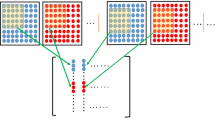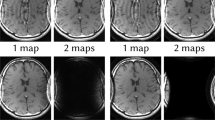Abstract
Parallel magnetic resonance imaging (MRI) is an imaging technique by acquiring a reduced amount of data in Fourier domain with multiple receiver coils. To recover the underlying imaging object, one often needs the explicit knowledge of coil sensitivity maps, or some additional fully acquired data blocks called the auto-calibration signals (ACS). In this paper, we show that by exploiting the between-frame redundancy of dynamic parallel MRI data, it is possible to achieve simultaneous coil sensitivity map estimation and image sequence reconstruction. Specially, we introduce a novel two-stage approach for dynamic parallel MRI reconstruction without pre-calibrating the coil sensitivity maps nor additionally acquiring any fully sampled ACS. Numerical experiments demonstrate that, the performance of the proposed approach is better than other state-of-the-art approaches for calibrationless dynamic parallel MRI reconstruction.






Similar content being viewed by others
Notes
Data source - http://challenge.ismrm.org/node/53
One might intuitively think that the the data frame with maximum number of samples in the auto-calibration region should be the best choice, but that is not true. For instance, in the second experiment of Sect. 5, the data frame with maximum number of samples in the auto-calibration region is frame 13, while exhaustive enumeration suggests frame 2 is the best choice, and the later one leads to significantly lower reconstruction error compared with the former one.
References
Beck, A., Teboulle, M.: A fast iterative shrinkage-thresholding algorithm for linear inverse problems. SIAM J. Imaging Sci. 2(1), 183–202 (2009)
Cai, J.-F., Candès, E.J., Shen, Z.: A singular value thresholding algorithm for matrix completion. SIAM J. Optim. 20(4), 1956–1982 (2010)
Chandrasekaran, V., Sanghavi, S., Parrilo, P., Willsky, A.S., et al.: Sparse and low-rank matrix decompositions. In: 47th Annual Allerton Conference on Communication, Control, and Computing, 2009. Allerton 2009, pp. 962–967. IEEE (2009)
Combettes, P.L., Wajs, V.R.: Signal recovery by proximal forward–backward splitting. Multiscale Model.Simul. 4(4), 1168–1200 (2005)
Daubechies, I., Defrise, M., De Mol, C.: An iterative thresholding algorithm for linear inverse problems with a sparsity constraint. Commun. Pure Appl. Math. 57(11), 1413–1457 (2004)
Ding, Q., Zan, Y., Huang, Q., Zhang, X.: Dynamic SPECT reconstruction from few projections: a sparsity enforced matrix factorization approach. Inverse Probl 31(2), 025004 (2015)
Gao, H., Lin, H., Ahn, C.B., Nalcioglu, O.: PRISM: A divide-and-conquer low-rank and sparse decomposition model for dynamic MRI. UCLA CAM Report (2011)
Gao, H., Rapacchi, S., Wang, D., Moriarty, J., Meehan, C., Sayre, J., Laub, G., Finn, P., Hu, P.: Compressed sensing using prior rank, intensity and sparsity model (PRISM): applications in cardiac cine MRI. In: Proceedings of the 20th Annual Meeting of ISMRM, Melbourne, Australia, pp. 2242 (2012)
Griswold, M.A., Jakob, P.M., Heidemann, R.M., Nittka, M., Jellus, V., Wang, J., Kiefer, B., Haase, A.: Generalized autocalibrating partially parallel acquisitions (GRAPPA). Magn. Reson. Med. 47(6), 1202–1210 (2002)
Huang, F., Akao, J., Vijayakumar, S., Duensing, G.R., Limkeman, M.: k–t GRAPPA: a k-space implementation for dynamic MRI with high reduction factor. Magn. Reson. Med. 54(5), 1172–1184 (2005)
Kreutz-Delgado, K.: The complex gradient operator and the cr-calculus. University of California, San Diego, version ucsd-ece275cg-s2009v1. 0, 25 june 2009. arXiv:0906.4835
Liang, D., DiBella, E.V., Chen, R.-R., Ying, L.: k-t ISD: Dynamic cardiac MR imaging using compressed sensing with iterative support detection. Magn. Reson. Med. 68(1), 41–53 (2012)
Liang, D., Liu, B., Wang, J., Ying, L.: Accelerating SENSE using compressed sensing. Magn. Reson. Med. 62(6), 1574–1584 (2009)
Liang, Z.-P.: Spatiotemporal imaging with partially separable functions. In: Joint Meeting of the 6th International Symposium on Noninvasive Functional Source Imaging of the Brain and Heart and the International Conference on Functional Biomedical Imaging, 2007. NFSI-ICFBI 2007, pp. 181–182. IEEE (2007)
Lustig, M., Donoho, D., Pauly, J.M.: Sparse mri: the application of compressed sensing for rapid MR imaging. Magn. Reson. Med 58(6), 1182–1195 (2007)
Lustig, M., Pauly, J.M.: SPIRiT: Iterative self-consistent parallel imaging reconstruction from arbitrary k-space. Magn. Reson. Med. 64(2), 457–471 (2010)
Otazo, R., Candès, E., Sodickson, D.K.: Low-rank plus sparse matrix decomposition for accelerated dynamic MRI with separation of background and dynamic components. Magn. Reson. Med. 73(3), 1125–1136 (2015)
Pruessmann, K.P., Weiger, M., Scheidegger, M.B., Boesiger, P.: SENSE: sensitivity encoding for fast MRI. Magn. Reson. Med. 42, 952–962 (1999)
Shen, Z., Toh, K.-C., Yun, S.: An accelerated proximal gradient algorithm for frame-based image restoration via the balanced approach. SIAM J. Imaging Sci. 4(2), 573–596 (2011)
Shin, P.J., Larson, P.E., Ohliger, M.A., Elad, M., Pauly, J.M., Vigneron, D.B., Lustig, M.: Calibrationless parallel imaging reconstruction based on structured low-rank matrix completion. Magn. Reson. Med. 72(4), 959–970 (2014)
Sodickson, D.K., Manning, W.J.: Simultaneous acquisition of spatial harmonics (SMASH): fast imaging with radiofrequency coil arrays. Magn. Reson. Med. 38(4), 591–603 (1997)
Uecker, M., Lai, P., Murphy, M.J., Virtue, P., Elad, M., Pauly, J.M., Vasanawala, S.S., Lustig, M.: ESPIRiT—an eigenvalue approach to autocalibrating parallel MRI: where SENSE meets GRAPPA. Magn. Reson. Med. 71(3), 990–1001 (2014)
Wang, J., Kluge, T., Nittka, M., Jellus, V., Kuhn, B., Kiefer, B.: Using reference lines to improve the SNR of mSENSE. In: Proceedings of the 10th Annual Meeting of ISMRM, Honolulu, p. 2392 (2002)
Zhao, T., Hu, X.: Iterative GRAPPA (iGRAPPA) for improved parallel imaging reconstruction. Magn. Reson. Med. 59(4), 903–907 (2008)
Author information
Authors and Affiliations
Corresponding author
Additional information
Hao Gao was partially supported by the NSFC (#11405105), the 973 Program (#2015CB856004), and the Shanghai Pujiang Talent Program (#14PJ1404500). L. Hou and X. Zhang were partially supported by NSFC (#91330102) and Sino-German center grant (GZ1025), China Postdoc Science Foundation (# 2014M551392), and 973 Program (# 2015CB856004).
Rights and permissions
About this article
Cite this article
Hou, L., Gao, H. & Zhang, X. A Two-Stage Low Rank Approach for Calibrationless Dynamic Parallel Magnetic Resonance Image Reconstruction. J Sci Comput 69, 1014–1032 (2016). https://doi.org/10.1007/s10915-016-0225-6
Received:
Revised:
Accepted:
Published:
Issue Date:
DOI: https://doi.org/10.1007/s10915-016-0225-6




